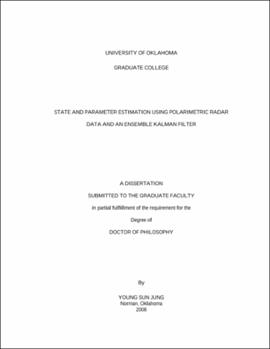| dc.contributor.advisor | Xue, Ming | |
| dc.creator | JUNG, YOUNG SUN | |
| dc.date.accessioned | 2019-06-03T20:35:53Z | |
| dc.date.available | 2019-06-03T20:35:53Z | |
| dc.date.issued | 2008 | |
| dc.identifier | 99325042702042 | |
| dc.identifier.uri | https://hdl.handle.net/11244/320231 | |
| dc.description.abstract | The US National Weather Service plans to upgrade the entire operational radar network to polarimetric capability early in the next decade. The goal of this dissertation is to develop methodologies that use polarimetric radar data in mesoscale data assimilation systems with the ensemble Kalman filter (EnKF). To directly assimilate polarimetric radar variables into numerical weather prediction models, two sets of comprehensive polarimetric radar simulators are developed. The observed quantities considered include reflectivities at horizontal and vertical polarizations (ZH and ZV, respectively), the differential reflectivity ZDR, the specific differential phase KDP, and the cross-correlation coefficient ρhv. The simulators are applied to a simulated squll-line system and a supercell storm. Simulated fields exhibit realistic polarimetric signatures that include ZDR and KDP columns, ZDR arc, mid-level ZDR and ρhv rings, and hail signatures along with the bright band signature in the stratiform region and deep reflectivity core in the convective region. These simulators are proven to be useful for validating model microphysics by 1) detecting a problem with the treatment of melting processes and 2) manifesting the limitation of a single-moment microphysics scheme in handling the mechanisms closely linked to the size sorting of precipitation particles. | |
| dc.description.abstract | The simpler but more efficient version of the polarimetric simulators is incorporated into the EnKF data assimilation system to define the observation operators. Various experiments are performed to: (1) assess the impact of assimilating additional polarimetric variables in the EnKF system based on a single-moment scheme, (2) simultaneously estimate fundamental microphysical parameters and atmospheric state in the presence of observation operator error due to uncertainty in the microphysical parameters, (3) evaluate the capability of the EnKF system to retrieve model state variables using both conventional and polarimetric radar data when a double-moment microphysics scheme is used. | |
| dc.description.abstract | The results based on observing system simulation experiments assuming either a perfect or imperfect prediction model show that the storm analysis is improved when polarimetric variables are assimilated in addition to ZH or in addition to both ZH and radial velocity Vr. The additional polarimetic data are more helpful when state and/or parameter estimation is not very successful using conventional radar data alone. The positive impact of polarimetric data is found in all state variables at all levels and more significant improvement is obtained in microphysical variables when the model error originating from the uncertain microphysical parameters is relatively large. The polarimetric variables are generally more beneficial to the analysis of rain water- and hail-related variables, and of the vertical velocity among the wind comonents. | |
| dc.description.abstract | It is also suggested that the polarimetrc variable that contains the most independent information content has the largest positive impact on the analysis. Between ZDR and KDP, ZDR is found to produce a larger positive impact in perfect model experiments because ZDR is less correlated with ZH than KDP is. In the microphysical parameter estimation experiments, KDP is generally more useful where the data are mostly selected from discrete regions of the storm while many of ZDR data seem to overlap ZH in location. The microphysical information provided by additional polarimetric radar data appears to help alleviate the solution non-uniqueness problem. This research is, to our knowledge, the first to directly assimilate (simulated) polarimetric radar data into a numerical weather prediction model. | |
| dc.format.extent | 231 pages | |
| dc.format.medium | application.pdf | |
| dc.language | en_US | |
| dc.relation.requires | Adobe Acrobat Reader | |
| dc.subject | Radar | |
| dc.subject | Polarimetry | |
| dc.subject | Kalman filtering | |
| dc.subject | Weather forecasting--Mathematical models | |
| dc.title | STATE AND PARAMETER ESTIMATION USING POLARIMETRIC RADAR DATA AND AN ENSEMBLE KALMAN FILTER | |
| dc.type | text | |
| dc.type | document | |
| dc.thesis.degree | Ph.D. | |
| ou.group | College of Atmospheric & Geographic Sciences::School of Meteorology | |
